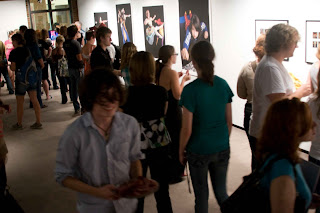Monday, September 21, 2009
Saturday, September 19, 2009
WPR: Spectrum West on "Residual Reality"
Tuesday, September 15, 2009
Monday, September 14, 2009
My Experience with Residual Reality
The residual reality show was an eye-opening experience for me. I learned a lot about not only the artists that were present, but also how photography is perceived. I felt this exhibit was quite worthwhile and I was happy I was able to attend. I had a chance to speak with two of the artists whose work I admired the most. It made for an eventful night. I felt the purpose of this exhibit was to connect the onlookers with photography and the many forms it comes in. I talked to Daniel Kaufman who also expressed how one of the best things about the show was that it will open the eyes of the community into what photography really entails, which isn’t just an ordinary picture.
I was happy I got a chance to speak with Ken Josephson too. I really appreciated his post cards and they were probably my favorite pieces in the show. I like how time was combined in a way with his work. The time lapses varied in each post card piece, but the way the old and new in the photos blended together made it very interesting. In the Chicago Bus station post card for example you were able to see what had changed just in a 10-year span of time. I felt the pieces of the photos were put together very well. The buildings from the new and old photos fit together perfectly. Josephson mentioned to me that Chicago was a place very near to his heart. He also loves Europe because of the history they have and the fact that they appreciate the history that they have, and the art they enjoy as well. He’s even been invited by the French center of Photography to work on various projects.
Seeing the art is one thing, but I was especially pleased to have met the people behind the pieces as well and get their take on their own work. I love learning about people and was very excited to have had the opportunity to meet such interesting people who have created such unique pieces. This show was very worthwhile as it has opened my eyes to what photography can be and I hope it has done the same for others as well.Despite these obvious differences however, there is clearly cohesiveness among this group. Each of these artists toy with the traditions of photography. They are occupied with questioning the notions of photography as documentary and images as the recreation of reality. Some are even negating the need for conventional photographs in the work o f photographers. Robert Heinecken describes his perspective on photography by saying, “Many Pictures turn out to be limp translations of the known world instead of vital objects which create an intrinsic world of their own. There is a vast difference between taking a picture and making a photograph,” (1).This curiosity, playfulness, and untraditional perspective among the artists resulted in an exhibit full of wit and sly humor, most predominately in Joyce Neimnana’s pieces, such as Back of a Famous Photograph, and Daniel Kaufmann’s sneaky and alluring House Home images. Even the work with less emphasis on witty experimentation was imaginative and unique, like Ellen Brook’s images shot through a screen.
More than the conceptual unity joining them, there is such an obvious personal connection between these artists. Especially during the artist’s forum, it became clear that Robert Heinecken and Ken Josephson’s legacy and artistic spirit is flowing rampantly and developing through these successful artists.
1. New York Times, May 26,2006. http://www.nytimes.com/2006/05/22/arts/heinecken.html?_r=1
The atmosphere, like many have stated, was full of energy and life. For some, this was a first time experience. It was easy to tell that this group had many mixed feelings. The reactions seen opening night and on this blog prove that an artist has the ability to change people's perspective. As an artist, it is inspiring to see this kind of reaction. For others more accustomed to art galleries, this experience still had a raw factor as well. It was interesting to see the different media vehicles used to help portray photography in a different light. Also, the interesting theme left the unanswered question in the audience's mind and helped set a tone for the exhibition. This theme guided the audience to really take a deeper look into the artwork to be able to see that different reality.
As previously stated, this exhibition was also unique in that the artists were very willing to interact with the crowd. These artists were very down to earth and I think that helped the audience to actively engage with them. I had the opportunity to talk to Patrick Nagatani and asked him how he thought the exhibit looked. He seemed to really enjoy how interested everyone was.
A further expansion of this connection came from the Round Table Discussion the next day. The discussion highlighted this artist lineage that should not be taken lightly. There is a deep connection and, being a part of Jyl's instruction, it is continuing. For me, everything from helping set up, going to the show, and finally seeing and hearing the artists speak at the discussion really motivates me to one day showcase my work in this fashion. I was moved by this exhibition as a whole and am glad that I was involved with history that night.












